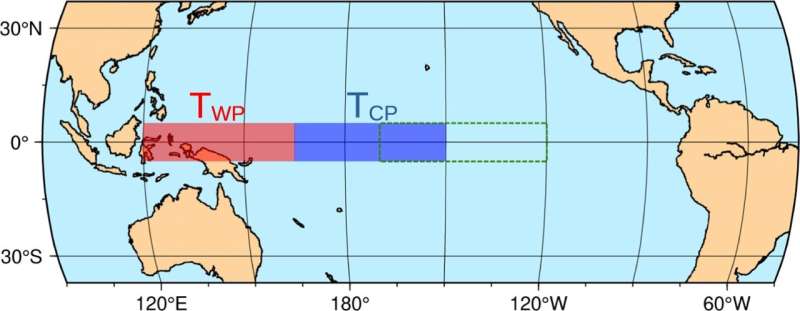This article has been reviewed according to Science X's editorial process and policies. Editors have highlighted the following attributes while ensuring the content's credibility:
fact-checked
peer-reviewed publication
proofread
A method for the early prediction of El Niño events with high hazard potential

At irregular intervals, a momentous weather phenomenon called El Niño (Spanish for "Christ Child") occurs in the Pacific. The warm surface water initially driven by the trade winds towards the coasts of Indonesia and eastern Australia then sloshes back eastwards, which can have devastating consequences.
Physicist Armin Bunde from Justus Liebig University Giessen (JLU), together with Josef Ludescher and John Schellnhuber from the Potsdam Institute for Climate Impact Research (PIK), has succeeded for the first time in developing a method that can be used to predict, with high accuracy and about one year in advance, how dangerous a coming El Niño will be. Their results have been published in the journal npj Climate and Atmospheric Science.
There are two different forms of this weather phenomenon: Often the warm surface water that sloshes back only reaches the center of the Pacific, in which case it is referred to as a Central Pacific El Niño. In some cases, however, the warm water reaches the eastern Pacific, which then warms significantly—this is the Eastern Pacific El Niño.
Both types can impact the climate, but the Eastern Pacific El Niño is much more dangerous, as it can cause severe droughts as well as heavy rainfall and flooding in many parts of the world. In addition, the high water temperatures off the coast of Peru and Chile ensure that the majority of fish retreat to cooler regions, leaving the fishing nets empty.
The method used by the physicists from Giessen and Potsdam to predict the type of an El Niño is based on the analysis of the water temperatures in the Western and Central Pacific since 1950.
Previously, scientists could only predict the onset of an El Niño about one year in advance, with the help of a climate network they had introduced earlier. However, the new method also makes it possible to forecast its type and thus its hazard potential.
"We can now correctly predict the type of an upcoming El Niño with a probability of 86%," says Josef Ludescher, first author of the study and former Ph.D. student of Armin Bunde.
"This means that if we obtain a forecast from our climate network at the end of the year that an El Niño is on its way and our new method indicates a Central Pacific El Niño, then we can already give some all-clear for the coming fall and winter. However, extreme caution is advised if the method points to an East Pacific El Niño. The long lead time coupled with the high accuracy is important to be able to initiate suitable adaptation measures in the affected areas at an early stage and thus prevent or at least mitigate possible disasters and protect human lives."
Armin Bunde also emphasizes the high quality of the new El Niño forecasting option. "Our early warning system is clearly superior to even the latest generation of Earth system models in terms of advance warning time and accuracy. Using our method, we had already predicted this year's East Pacific El Niño in December 2022."
More information: Josef Ludescher et al, Forecasting the El Niño type well before the spring predictability barrier, npj Climate and Atmospheric Science (2023). DOI: 10.1038/s41612-023-00519-8
Journal information: npj Climate and Atmospheric Science
Provided by Justus-Liebig-Universität Gießen



















